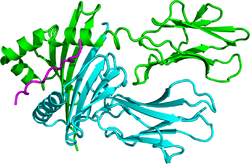1aqd: HLA-DR1 (DRA, DRB1 0101) HUMAN CLASS II HISTOCOMPATIBILITY PROTEIN (EXTRACELLULAR DOMAIN) COMPLEXED WITH ENDOGENOUS PEPTIDE
1bx2: CRYSTAL STRUCTURE OF HLA-DR2 (DRA*0101,DRB1*1501) COMPLEXED WITH A PEPTIDE FROM HUMAN MYELIN BASIC PROTEIN
1d5m: X-RAY CRYSTAL STRUCTURE OF HLA-DR4 COMPLEXED WITH PEPTIDE AND SEB
1d5x: X-RAY CRYSTAL STRUCTURE OF HLA-DR4 COMPLEXED WITH DIPEPTIDE MIMETIC AND SEB
1d5z: X-RAY CRYSTAL STRUCTURE OF HLA-DR4 COMPLEXED WITH PEPTIDOMIMETIC AND SEB
1d6e: CRYSTAL STRUCTURE OF HLA-DR4 COMPLEX WITH PEPTIDOMIMETIC AND SEB
1dlh: CRYSTAL STRUCTURE OF THE HUMAN CLASS II MHC PROTEIN HLA-DR1 COMPLEXED WITH AN INFLUENZA VIRUS PEPTIDE
1fv1: STRUCTURAL BASIS FOR THE BINDING OF AN IMMUNODOMINANT PEPTIDE FROM MYELIN BASIC PROTEIN IN DIFFERENT REGISTERS BY TWO HLA-DR2 ALLELES
1fyt: CRYSTAL STRUCTURE OF A COMPLEX OF A HUMAN ALPHA/BETA-T CELL RECEPTOR, INFLUENZA HA ANTIGEN PEPTIDE, AND MHC CLASS II MOLECULE, HLA-DR1
1h15: X-RAY CRYSTAL STRUCTURE OF HLA-DRA1*0101/DRB5*0101 COMPLEXED WITH A PEPTIDE FROM EPSTEIN BARR VIRUS DNA POLYMERASE
1hqr: CRYSTAL STRUCTURE OF A SUPERANTIGEN BOUND TO THE HIGH-AFFINITY, ZINC-DEPENDENT SITE ON MHC CLASS II
1hxy: CRYSTAL STRUCTURE OF STAPHYLOCOCCAL ENTEROTOXIN H IN COMPLEX WITH HUMAN MHC CLASS II
1j8h: Crystal Structure of a Complex of a Human alpha/beta-T cell Receptor, Influenza HA Antigen Peptide, and MHC Class II Molecule, HLA-DR4
1jwm: Crystal Structure of the Complex of the MHC Class II Molecule HLA-DR1(HA peptide 306-318) with the Superantigen SEC3
1jws: Crystal Structure of the Complex of the MHC Class II Molecule HLA-DR1 (HA peptide 306-318) with the Superantigen SEC3 Variant 3B1
1jwu: Crystal Structure of the Complex of the MHC Class II Molecule HLA-DR1 (HA peptide 306-318) with the superantigen SEC3 Variant 3B2
1kg0: Structure of the Epstein-Barr Virus gp42 Protein Bound to the MHC class II Receptor HLA-DR1
1klg: Crystal structure of HLA-DR1/TPI(23-37, Thr28-->Ile mutant) complexed with staphylococcal enterotoxin C3 variant 3B2 (SEC3-3B2)
1klu: Crystal structure of HLA-DR1/TPI(23-37) complexed with staphylococcal enterotoxin C3 variant 3B2 (SEC3-3B2)
1lo5: Crystal structure of the D227A variant of Staphylococcal enterotoxin A in complex with human MHC class II
1pyw: Human class II MHC protein HLA-DR1 bound to a designed peptide related to influenza virus hemagglutinin, FVKQNA(MAA)AL, in complex with staphylococcal enterotoxin C3 variant 3B2 (SEC3-3B2)
1r5i: Crystal structure of the MAM-MHC complex
1seb: COMPLEX OF THE HUMAN MHC CLASS II GLYCOPROTEIN HLA-DR1 AND THE BACTERIAL SUPERANTIGEN SEB
1sje: HLA-DR1 complexed with a 16 residue HIV capsid peptide bound in a hairpin conformation
1sjh: HLA-DR1 complexed with a 13 residue HIV capsid peptide
1t5w: HLA-DR1 in complex with a synthetic peptide (AAYSDQATPLLLSPR)
1t5x: HLA-DR1 in complex with a synthetic peptide (AAYSDQATPLLLSPR) and the superantigen SEC3-3B2
1ymm: TCR/HLA-DR2b/MBP-peptide complex
1zgl: Crystal structure of 3A6 TCR bound to MBP/HLA-DR2a
2fse: Crystallographic structure of a rheumatoid arthritis MHC susceptibility allele, HLA-DR1 (DRB1*0101), complexed with the immunodominant determinant of human type II collagen
2g9h: Crystal Structure of Staphylococcal Enterotoxin I (SEI) in Complex with a Human MHC class II Molecule
2iam: Structural basis for recognition of mutant self by a tumor-specific, MHC class II-restricted TCR
2ian: Structural basis for recognition of mutant self by a tumor-specific, MHC class II-restricted TCR
2icw: Crystal structure of a complete ternary complex between TCR, superantigen, and peptide-MHC class II molecule
2ipk: Crystal Structure of the MHC Class II Molecule HLA-DR1 in Complex with the Fluorogenic Peptide, AcPKXVKQNTLKLAT (X=3-[5-(dimethylamino)-1,3-dioxo-1,3-dihydro-2H-isoindol-2-yl]-L-alanine) and the Superantigen, SEC3 Variant 3B2
2oje: Mycoplasma arthritidis-derived mitogen complexed with class II MHC molecule HLA-DR1/HA complex in the presence of EDTA
2seb: X-RAY CRYSTAL STRUCTURE OF HLA-DR4 COMPLEXED WITH A PEPTIDE FROM HUMAN COLLAGEN II









































